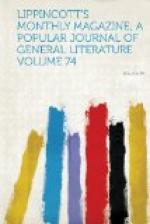places. How much more interesting to find an old
tomb or quaint “brass” under the temple
of a wild rosebush or in the firm clasp of an ivy-root
than to walk up to it and read the inscription newly
scraped and cleaned by the voluble attendant who volunteers
to show you the place! The great elms by Overton
Church and the half-timbered and thatched houses crowding
up to its gates somewhat make up for the splendor
of the coped wall and new monuments in the churchyard.
A scene wholly old is the Erbistock Ferry, which one
might mistake for a rope-ferry on the Mosel. The
cottage looks like the dilapidated lodge of an old
monastery, and here, at least, is no trimness.
Two walls with a flight of steps in each enclose a
grass terrace between them, and trees and bushes straggle
to the edge of the river, hardly keeping clear of
the swinging rope. Coracles are sometimes used
for ferrying—also punts. Bangor is
a familiar name to students of church history, and
to those who are not, the startling tale of the massacre
of twelve hundred British monks by the Saxon and heathen
king of Northumbria, who conquered Chester and invaded
Wales in the seventh century, is repeated by the local
guides. At present, Bangor is interesting to anglers
and to lovers of curiosities—to the former
as a good salmon-ground, and to the latter for the
quaint verses, which, though trivial in themselves,
borrow a value from the date of their inscription
and the “laws” to which they refer.
They are on the wall of the lower story of the bell-tower:
[Illustration: In the vale of
Llangollen.]
If that to ring you would
come here,
You must ring well with hand
and ear;
But if you ring in spur or
hat,
Fourpence always is due for
that;
But if a bell you overthrow,
Sixpence is due before you
go;
But if you either swear or
curse,
Twelvepence is due; pull out
your purse.
Our laws are old, they are
not new;
Therefore the clerk must have
his due.
If to our laws you do consent,
Then take a bell: we
are content.
[Illustration: Llangollen.]
Farndon Bridge and Wrexham Church (the latter looks
like a small cathedral to the unpractised eye) are
the last Welsh points of attraction before the Dee
becomes quite an English river. Malpas (mauvais
pas = “bad step"), on the English bank,
is significantly so-called from its situation as a
border town: the rector, too, might consider
it not ill named, as regards the odd partition of
the church tithes, which has been in force from time
immemorial, and has given rise to an explanatory legend
concerning a travelling king whom the resident curate
wisely entertained in the absence of the rector, receiving
for his guerdon a promise of an equal share in the
income, not only for himself, but for all future curates.
In the upper rectory (the lower is the curate’s
house) was born Bishop Heber in 1783, and in the early




